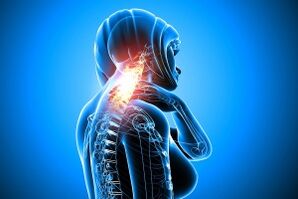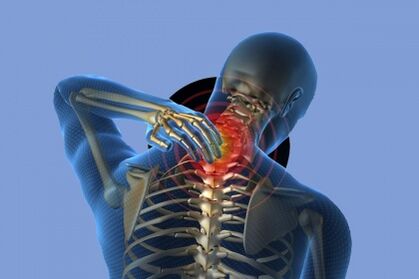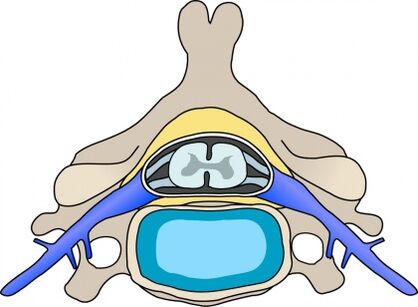
Headache, dizziness, blood pressure, and ear noise can be symptoms of spinal problems.In both cases, treatment for osteochondrosis in the cervical spine is required and complaints about this symptom are raised.
The particularity of the site structure makes it the maximum load, and any changes in degenerative changes are reflected in the patient's general wellbore.
Osteochondrosis in the cervical spine can cause hypertension, brain and motor function.The late stages of the disease are not actually treated.How to treat osteochondrosis in the cervical vertebrae?
Treatment depends on the degree of disease development
The treatment of cervical osteochondrosis depends on the extent of bone and cartilage damage.In the initial stages, simple gymnastics and general enhancement and vitamins can help.
First, after applying for a complaint, the doctor immediately formulated general clinical pictures, prescribed for examination and considered symptoms, and took into account the needs of the patient, and after collecting the medical history, osteochondrosis treatment for the cervical vertebrae was prescribed.

In the case of worsening and restorative therapy, medication for cervical osteochondrosis is prescribed.The following drugs are recommended:
- First-grade cervical osteochondrosis.Symptoms are insignificant.Basically, tension in muscle ligaments and small pain syndromes in nerve nodules were observed.Treatment includes the use of physical therapy procedures, vitamin complexes, exercise therapy.During this period, ointments used to treat neck bones and bone cartilage are very effective.
- Osteocartilage degeneration at 2 degrees on the neck.The pain begins to migrate.There is numbness of bone cartilage on the fingers and the feeling of "chicken skin" on the limbs.During this developmental stage, significant deformation of muscle tissue as well as metabolic diseases were observed.As a result, cells in the nucleus of the disc jacket began to die.Medication is designed to overcome symptoms and external manifestations.Prescription anti-inflammatory drugs, in some cases, are recommended for blockade of affected areas.
- Cervical osteochondrosis is 3 degrees.The vertebrae becomes unstable and may form a strong, hernia or a hernia.The pressure soars in hands, cervical osteochondria, and partially or completely paralyzed in the human body.Depending on the degree of violation, non-hormonal drugs are prescribed to reduce inflammation.If this doesn't help, they can do hormone therapy.In any case, vasodilation medications will be prescribed.
- Osteochondrosis on the neck is 4 degrees.It is characterized by scarring in the location of the disk jacket.At this stage, symptom treatment is performed for drug treatment of cervical osteochondrosis.In addition to the main treatment methods, other medications can be administered according to complications and clinical conditions.For example, if a spinal ischemic stroke cannot be performed promptly, treatment of cervical osteocartilage may be required for vertebral artery syndrome.As the most common consequence of paralysis and loss of limb sensitivity.
The cervical spine movements developed rapidly and progressed.Since all treatments are designed to eliminate symptoms, effective treatment is needed to prescribe the development of the disease.Osteocartilage degeneration in the intervertebral disc in the cervical area is damaged by irreversible features.
Treatment depends on performance and clinical condition
The signs of cervical osteochondrosis are both obvious and almost invisible until the degenerative disease begins to develop due to pathology.
Some patients first learn about the existence of the disease after seeking severe numbness in the collar area.In this case, the treatment of aggravated changes in cervical osteocartilage is essentially the following factors:
- It is necessary to repair damaged departments with bandages before starting treatment of cervical osteochondrosis.You will have to walk in for at least 10 days.
- Non-hormonal therapy is stipulated.Osteochondrosis in high cervical areas is usually well treated, and inflammation can be removed after full treatment.The composition of anti-inflammatory drugs includes painkillers, so blocking can only be done if pain cannot be relieved.
- After reducing the symptoms of cervical vertebrae and opaque bone, treatment is started to resume.A set of vitamins and minerals is specified and a cartilage protector can be recommended.

In acute osteocartilage of the neck, drugs that relieve inflammation have a negative impact on the human gastrointestinal system.Therefore, when prescribing treatment plans, neurologists should recommend means to restore gut microbiota and their support under normal circumstances.
Chronic osteocartilage requires different treatments.Since in this case the inflammatory process is not a major symptom of the disease, treatment will be supportive and preventive.Osteochondrosis in the collar area requires the use of various physical therapy methods: acupuncture, Hirudotherapy, manual therapy, and the implementation of a series of physical therapy exercises.
The medication is prescribed only if the neck is acutely detached from the osteocartilage, in which case the treatment will be the same as one described above.
Under what circumstances is surgery recommended
If all measures aimed at eliminating the inflammatory process of stages 3-4 of the disease do not result in any results, surgical treatment of cervical osteochondrosis is required.In this case, the usual treatment time is about six months.However, if the patient becomes stable in the wellbore, the treatment process for cervical osteochondrosis can be reduced.
The needle-plurred limbs and unbearable pain are indications for early surgery.
Treatment of osteocartilage degeneration in the cervical spine is usually performed with more favorable results and requires no more than 10% of all cases.If the disease threatens the patient's life, it may be necessary to operate, and it may also be correct if vertebral artery syndrome cervical osteochondrosis is observed.

Reason for appearance
So far, due to this pathological reasons, there is no definite information.However, factors that contribute to their appearance have been well studied.
- Osteochondral disease in the cervical area of children.This is due to hormone changes associated with the growth process.This is due to genetic tendency.
- The consequences of injury.Due to spinal trauma, compression fractures in osteocartilage muscle recovery occur within a few months to six months.In a few years, the consequences of the impact of the seat belt can be demonstrated.In the accident, more than 30% of all cases of all patients were observed with cervical inconsistent osteocartilage degeneration of the intervertebral disc.
- Surrounding factors.Seated work, a sedentary lifestyle, malnutrition – all of which are the causes of pathological development.During the chronic form, cervical osteochondral disease can be observed on the nerve soil.
When should you see a doctor?
All symptoms of cervical osteochondrosis are direct advice from visiting experts.The advanced form of the disease can lead to severe aggravation.If you observe what SO calls "Terry Osteochondrosis" after lifting the body's severity or sharp rotation, you should consult your doctor immediately.This indicates that the pathological process is in the late stage of development.























